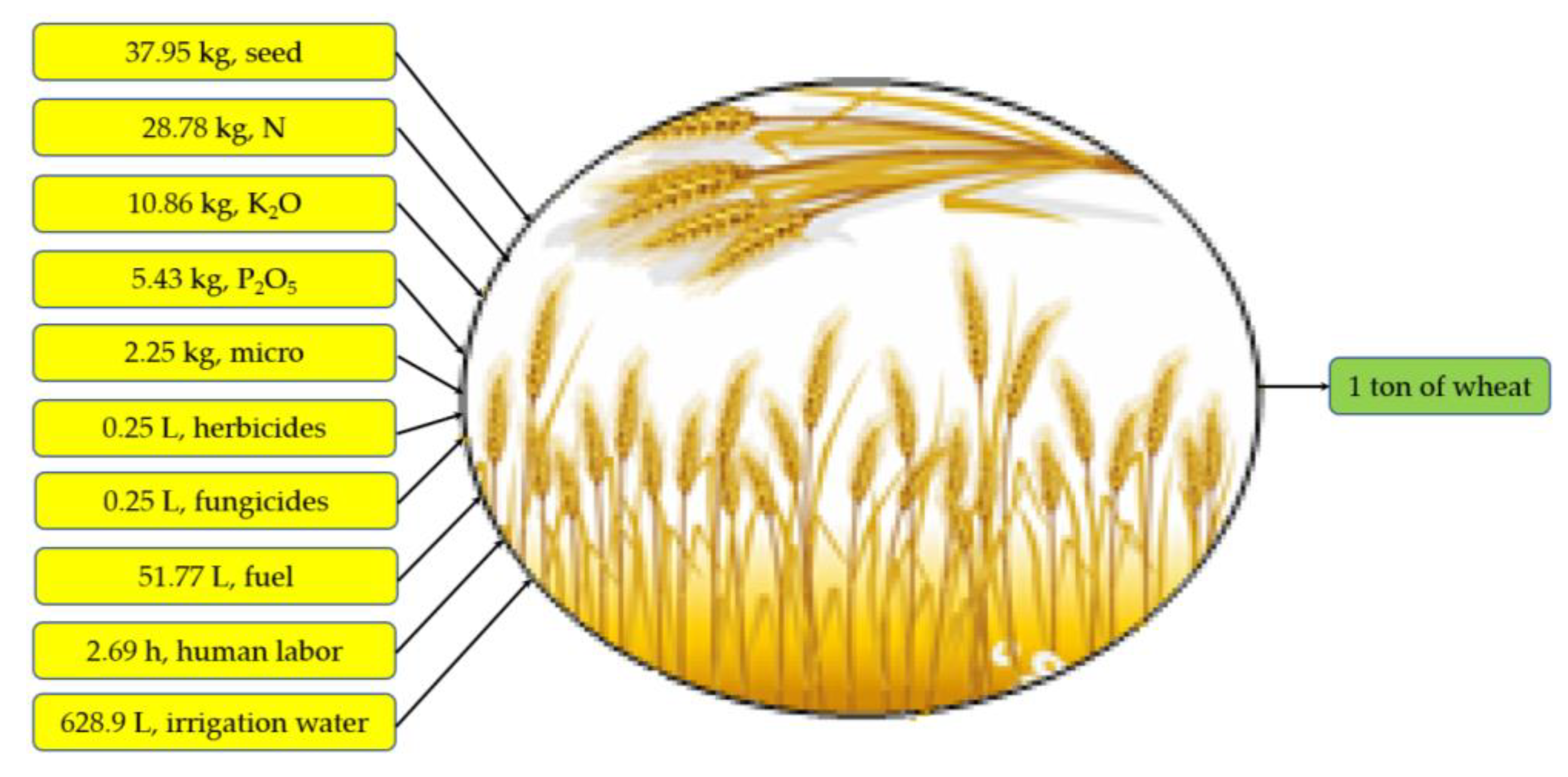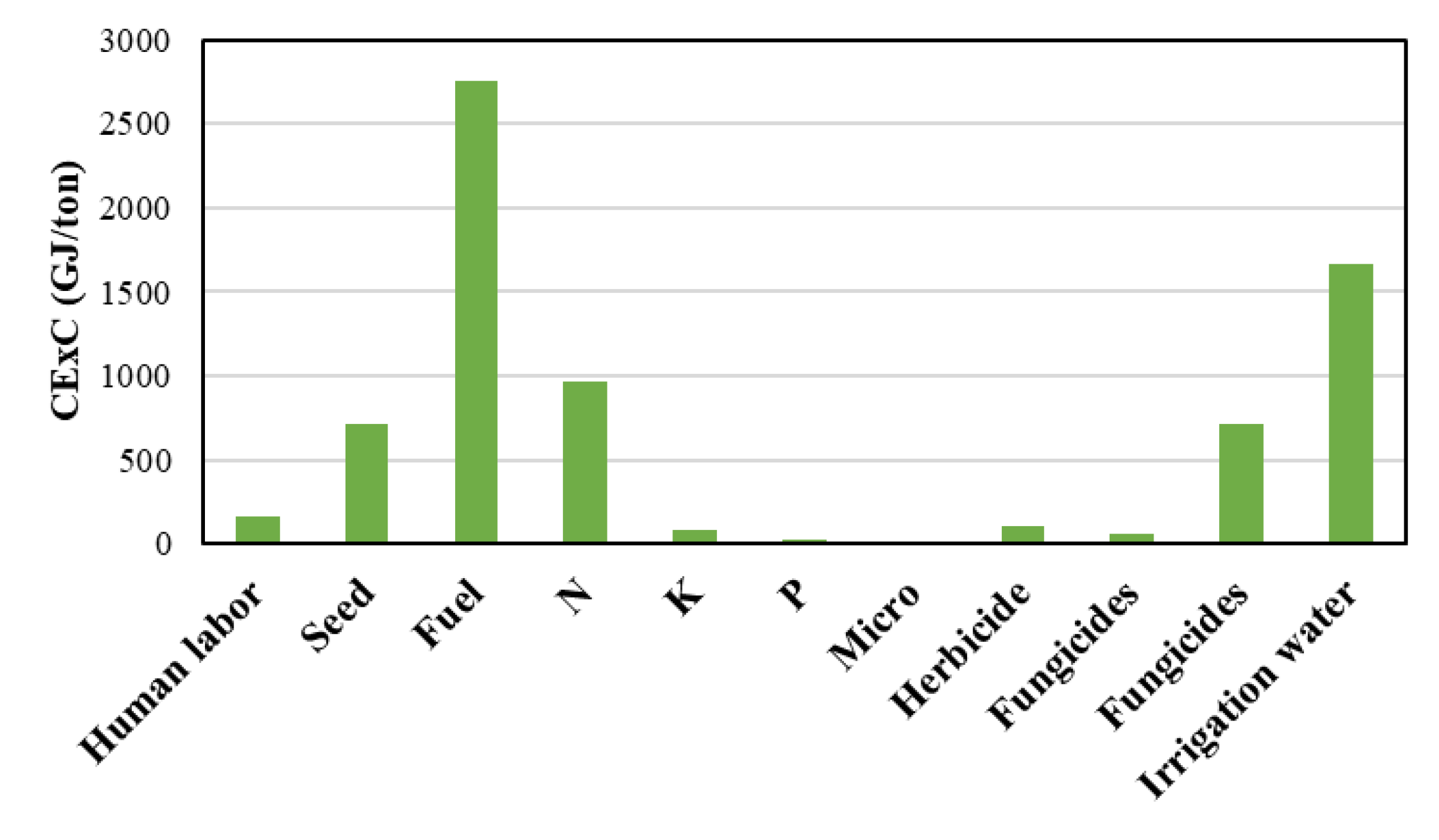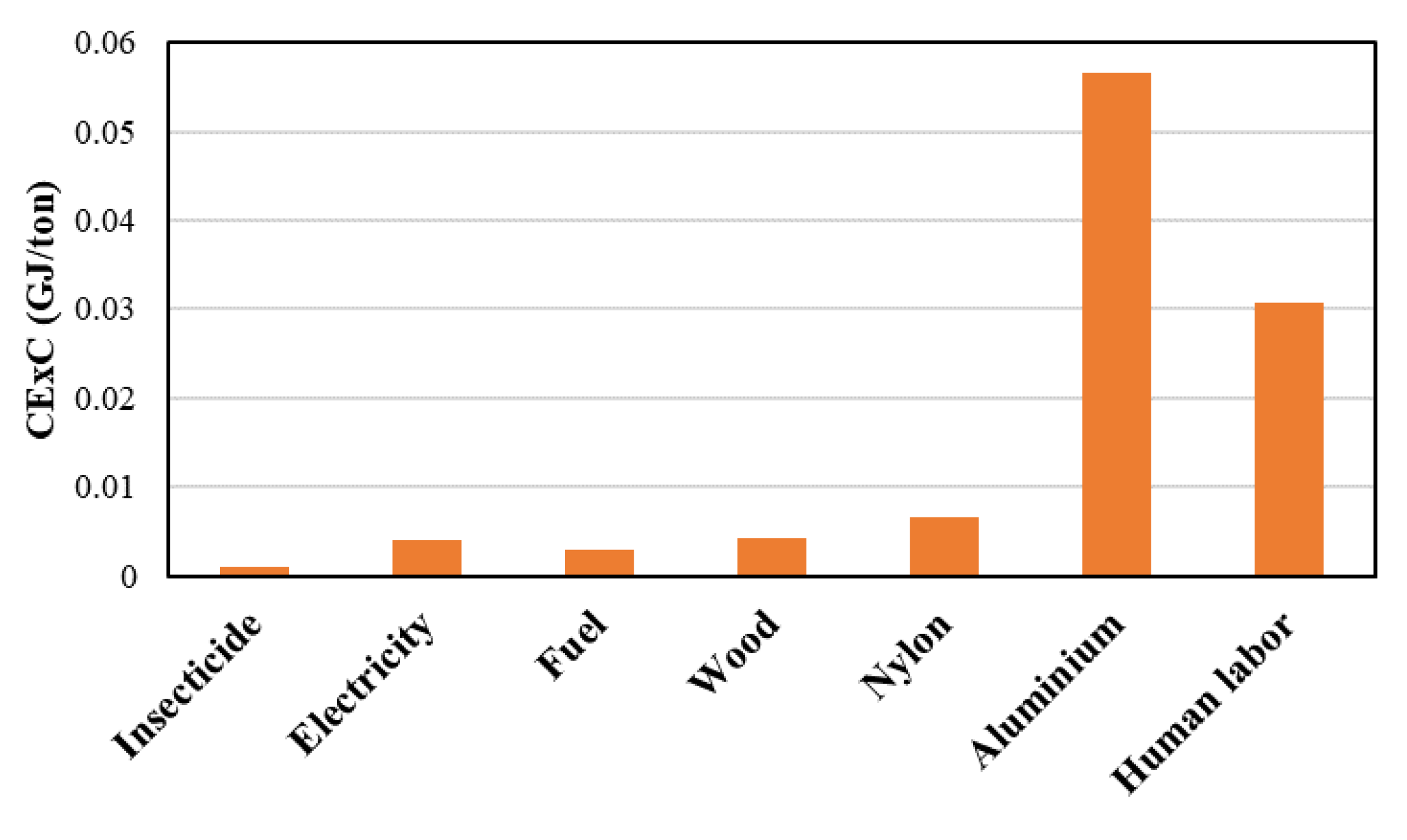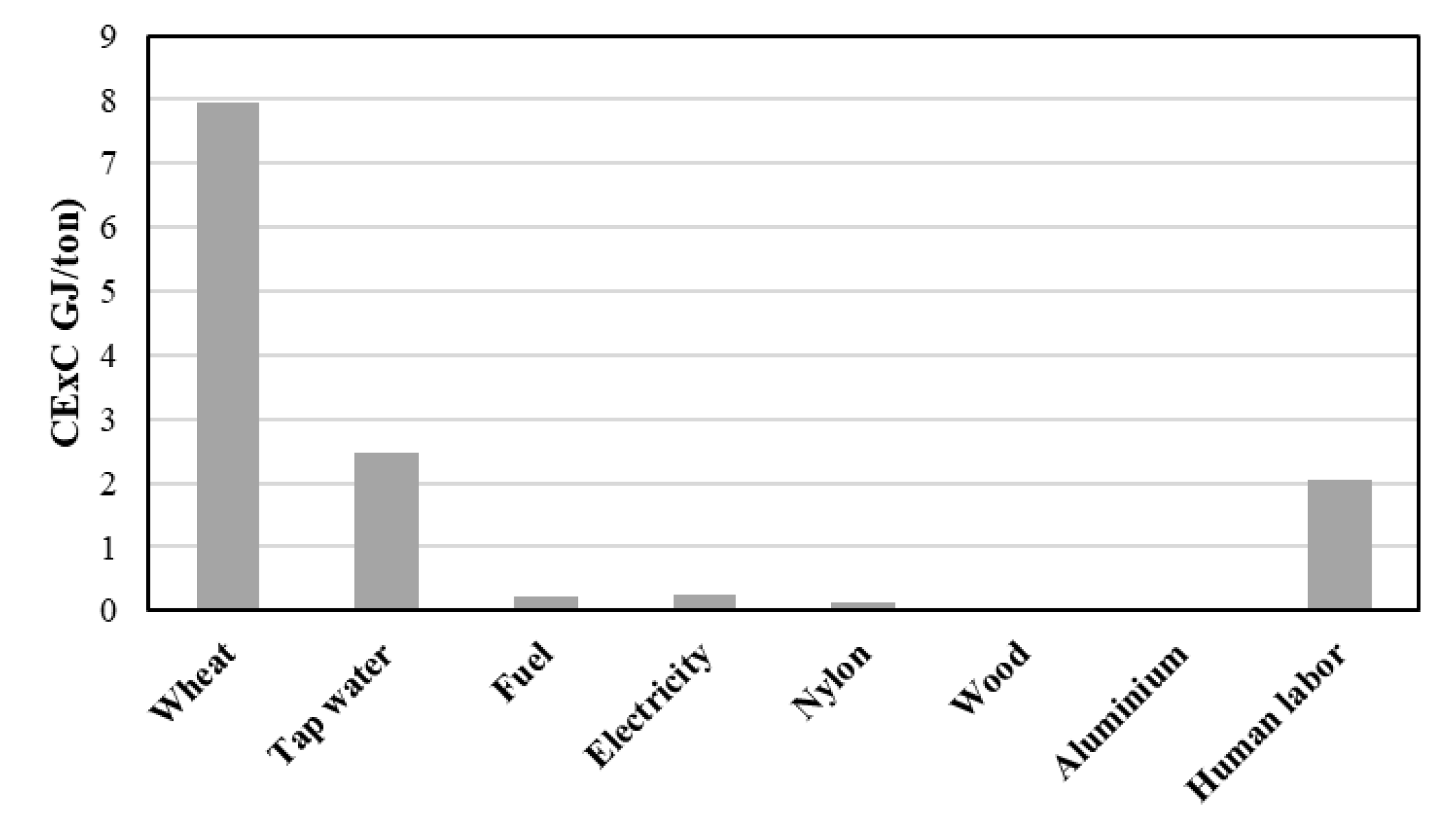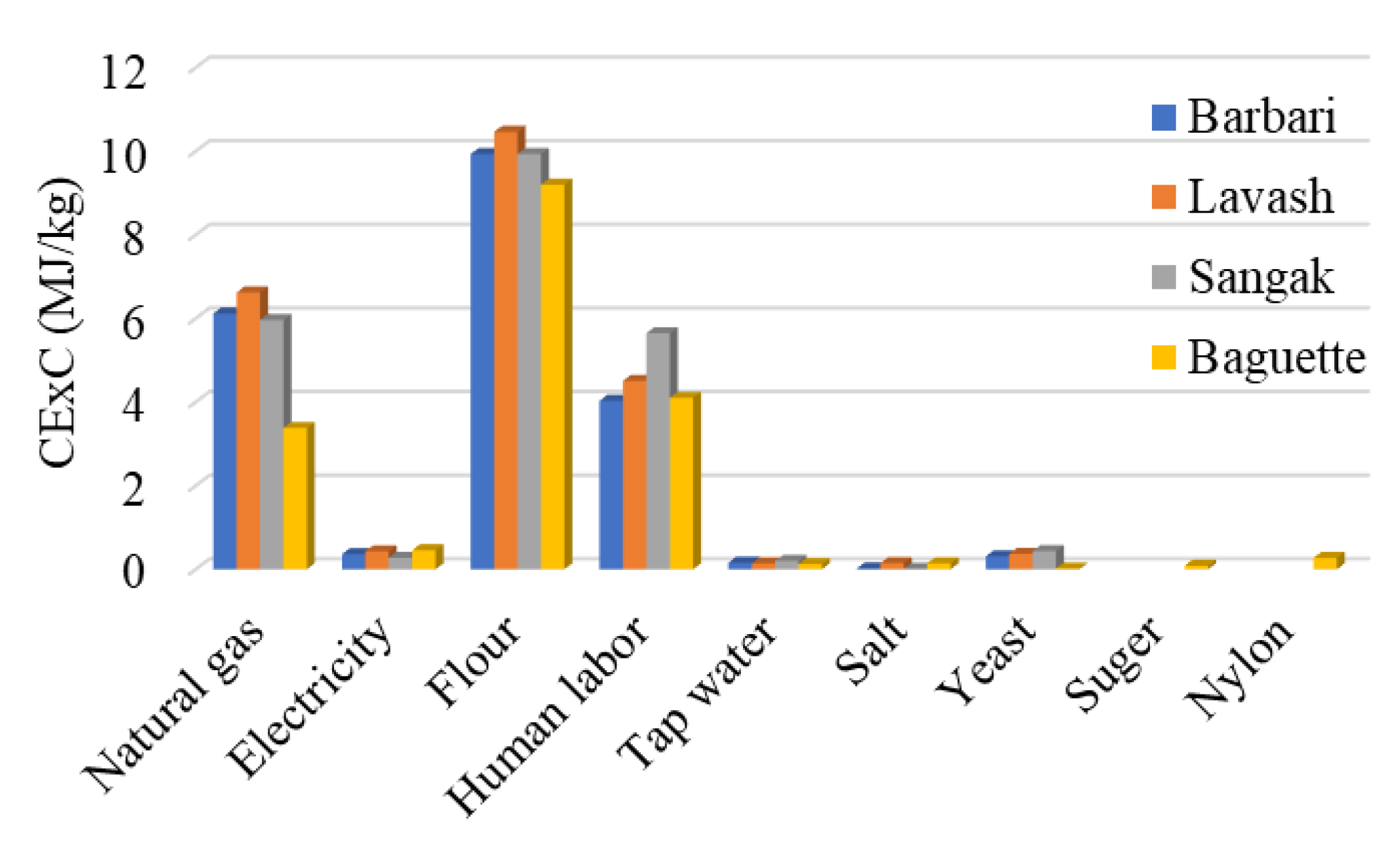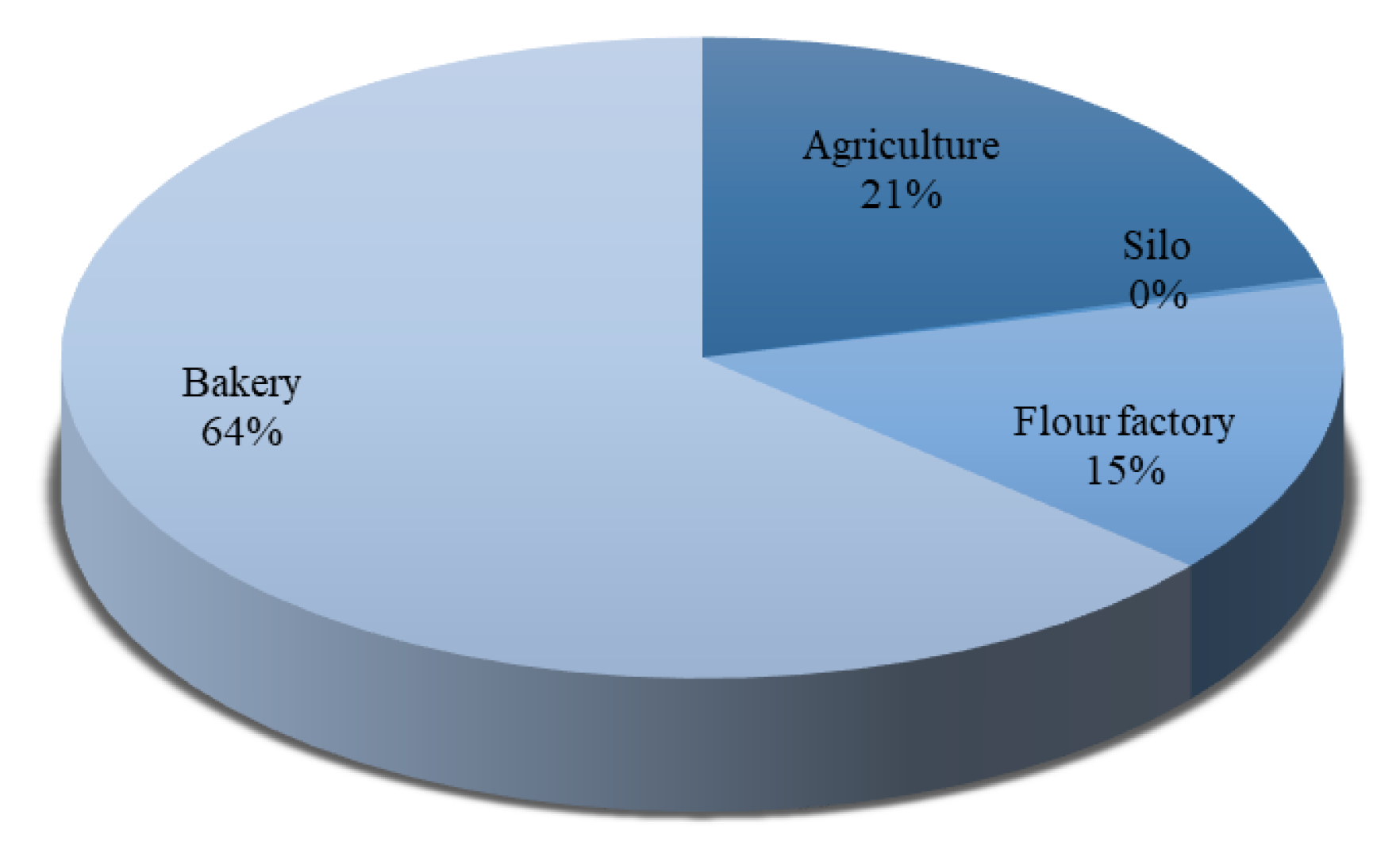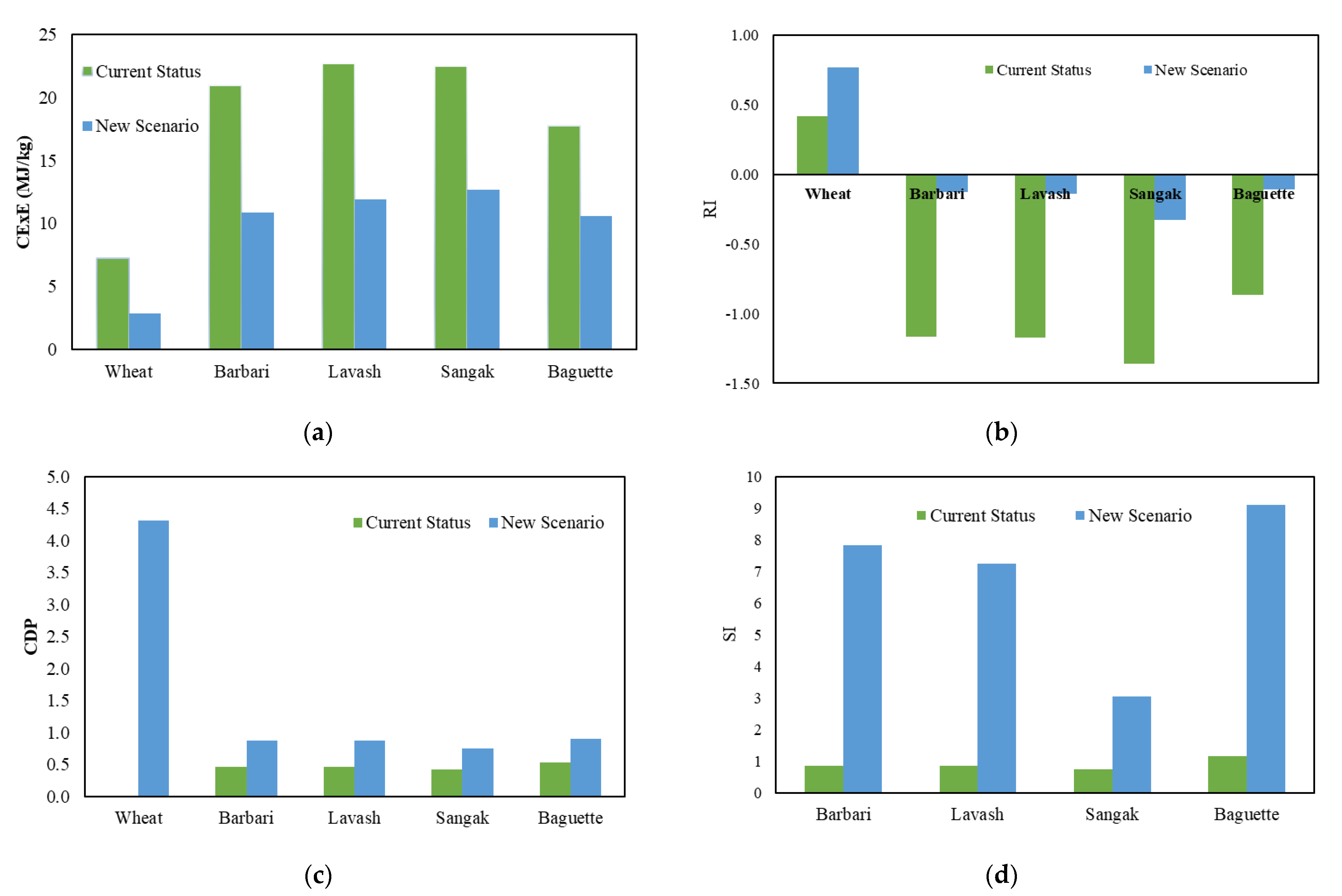1. Introduction
In the modern world, food consumption is inevitably related to processing. As the level of the development of societies and countries increases, the level of food processing also increases. The complexity of issues related to sustainable production has led food experts and scientists to search for different solutions and address different issues related to sustainable food processing [
1]. Inedible raw materials are converted into food for human consumption through primary, secondary, and tertiary processing. The conversion of inedible raw products into food is part of primary processing. Planting, growing, harvesting, storage, processing, packaging and transportation, slaughtering animals for food are some of the basic stages of primary processing. Other examples of primary processing are wheat cultivation and the production of wheat flour. Primary processing products are either sent to the market for retail sale or sent to factories as ingredients for secondary or tertiary processes. Secondary processing includes the food conversion into edible foods (different types of food from primary processes are combined). Secondary processed foods are at the home or industrial level (bread production at home or in a factory using raw materials, yeast, salt, and other food items) [
2].
Most studies have been focused on energy consumption and the calculation of the energy index of the production of agricultural products. In this method, researchers use the conventional energy method to evaluate the total energy input and use the contribution of each input for economic analyses and optimization methods. However, the quality of resources (such as fossil fuels, electricity, fertilizers, and biocides) as well as energy conversion have not been evaluated in energy studies. Energy analysis is solely based on the first law of thermodynamics and depends on the system and process and therefore lacks generality and does not provide any information about alternative methods to do the same work with the aim of saving energy and reducing heat loss. Exergy analysis can be used as an innovative way to overcome this limitation, wherein exergy is a concept based on the second law of thermodynamics. Analysis of exergy can provide an effective use of energy resources and helps manufacturers better use energy in product production [
3]. Cumulative exergy consumption (CExC) is an analytical method based on the concept of exergy. The CExC technique can evaluate the real energy-exergy consumption of all inputs in each process. The exergy performance of agricultural production can be calculated based on the inputs and thermodynamic chemical properties of the outputs [
4]. With the CExC approach, it is possible to analyze the renewability index (RI) and sustainability index (SI) of a given product’s production process and help manufacturers to improve production efficiency. For example, in the preparation of strawberry-flavored yogurt, researchers concluded that by using hydropower to generate electricity, the exergy efficiency of the production process increases from 3.7% to 4.6% [
5]. In greenhouse cucumber cultivation, the replacement of renewable resources with fossil resources increased the CDP (cumulative degree of perfection) from 0.23 to 0.47 and RI from −3.32 to 1.09 [
6]. The use of biodiesel and biofertilizers significantly increased the efficiency of the soybean, olive, and sunflower oil production process [
7]. The exergy analysis of tomato cultivation by open field and greenhouse methods in Turkey showed that the consumption of water and electricity had caused the non-renewability of open field and greenhouse tomato cultivation, respectively and that the use of renewable resources increased the renewability index from 0.3 to 0.71 [
8]. In another study, the use of pellet fertilizer increased the efficiency of the potato cultivation system [
9]. Yildizhan et al. [
10] showed that renewable sources reduced the exergy of apple production from 9.4 to 0.58 GJ t
−1. Degerli et al. [
2] estimated CExC in wheat-bread and rye-bread chain for Turkey and Germany. They concluded that maximum exergy destruction occurred in milling and baking operations.
Although Iran is second worldwide in the production and consumption of bread after Turkey, our literature review showed that the sustainability of the wheat-bread production chain in Iran has not been investigated so far. The current study aimed to use the CExC method to evaluate the system efficiency, renewability, and sustainability of wheat and bread production. From the point of view of the CExC, the operations and inputs of non-renewability and unsustainability were identified. Finally, based on the CExC approach, the improvement in CDP and RI factors was investigated. It was assumed that, in wheat production, the farmers used biofuel as an alternative to diesel fuel and microbial fertilizer as an alternative to chemical and animal fertilizers. It is expected that our results will help to initiate more economical and sustainable measures in the bread industry.
3. Results and Discussion
Figure 2 shows the exergy of inputs used to produce 1 ton of wheat. The total cumulative consumption of exergy for wheat production was estimated to be 7.24 GJ t
−1. The highest consumption of exergy is related to fuel (38%), followed by water (23%), and nitrogen fertilizer (13.3%) is the third most effective input in exergy. The share of other inputs is less than 10%. As a result, the consumption of diesel, fertilizers, and water should be balanced so as to save on the use of exergy for wheat production.
The exergy value of water wheat production in Khuzestan province, Iran was reported to be 7.7 GJ t
−1. The researchers attributed the high CExC contribution to the high consumption of electricity used to extract water from the deep well. Degerli et al. [
2] estimated the CExC of wheat for Turkey and Germany at 4.7 and 1.6 GJ t
−1, respectively; the reason for the lower CExC of wheat production in Turkey and Germany compared to Iran was the use of cultivars with higher yield wheat in Turkey and Germany [
31]. The CExC was estimated at 1.15 for rye in Turkey, 1.94 for rye in Germany [
2], 9.4 for apple [
10], 41.4 for cucumber [
6], 2.21 for potato [
9], 6.7 for strawberry [
32] and 1.07 GJ t
−1 for tomato [
9].
After harvesting, the wheat is transferred to the silo for storage and then to the flour factory to prepare wheat flour.
Figure 3 shows the exergy used by the silo and the flour factory. The CExC of ensiling wheat was estimated to be 0.11 GJ t
−1. According to
Figure 4, aluminum and human labor had the greatest impact on exergy consumption. For every 1.1 ton of wheat, 1 ton of flour was obtained in the flour factory. In total, the CExC of the flour factory was estimated at 17.5 GJ t
−1. The highest share of the CExC of the flour factory is related to water and human labor.
Figure 5 shows the CExC of inputs used in different bakeries to produce 1 kg of bread. The CExC of Barbari, Lavash, Sangak, and Baguette breads were evaluated to be 27, 20.94, 22.69, 22.46, and 17.78 MJ kg
−1, respectively. Baguette bread had the lowest CExC and Lavash bread had the highest CExC. The flour input in all breads had the highest CExC, which was due to the high CExC in wheat farming and flour mill operations. By optimizing the flour preparation process in the factory, by using high-yield cultivars or by using new machines and equipment, and by replacing biological fertilizers, a significant reduction in CExC can be achieved. After flour input, natural gas and human labor inputs had the highest share in the exergy consumption of bread. By industrializing the bread production process and using biofuels, the CExC in this sector can be reduced.
In other conversion processes with a fork-to-field approach, the CExC for the production of olive oil (43.05 MJ kg
−1), sunflower oil (17.64 MJ kg
−1), soybean oil (26.45 MJ kg
−1) [
7], wheat bread (16.6 MJ kg
−1), rye bread (14.7 MJ kg
−1), hamburger bun (25.2 MJ kg
−1) [
2], black tea (43.53 MJ kg
−1) [
33], yogurt (74.65 MJ kg
−1), strawberry jam (16.75 MJ kg
−1) [
5], and prune (51.00 MJ kg
−1) [
34] was estimated.
Figure 6 shows the CExC of bread from the farm to the bakery. As can be seen, the bakery had the highest share of CExC in the wheat-bread chain with 64% of total CExC. After bakery, agriculture had the second highest exergy-consuming operation with 21% of total CExC, followed by the flour factory with 15% of CExC. The silo had a low share of exergy consumption. Therefore, to increase the sustainability of the wheat-bread chain, special attention should be paid to the inputs used in bakeries. As
Figure 5 shows, the input of natural gas in the bakery was the cause of the unsustainability of the bakery. By using biogas, it is possible to reduce CExC while reducing environmental pollution.
As can be seen in
Figure 5, considering the functional unit of the weight of the produced bread, the CExC of Baguette bread was the lowest. Considering the functional unit of the energy of the bread, i.e., 100 cal, Barbari bread had the lowest CExC per 100 cal of embedded energy (
Figure 7a). Whether it is the functional unit of weight or embedded energy of bread, Sangak bread had the highest CExC.
Figure 7b shows the CExC based on the cost spent in the preparation of inputs. The investment factor for Baguette bread is 76 MJ
$−1, 94 MJ
$−1 for Barbari bread, 96 MJ
$−1 for Lavash bread, and 94 MJ
$−1 for Sangak bread. In other words, considering the functional unit of the bread production cost, Baguette bread consumed less exergy per monetary unit. The high specific capital conversion in traditional bread shows that the production of traditional bread requires more resources and therefore the ratio of exergy to cash flow was higher for traditional bread than for semi-industrial bread.
In this research, the capital factor for wheat production was found to be 81 MJ
$−1. Amiri et al. [
35] obtained a capital factor of 167 MJ
$−1 for canola production.
With the help of the CDP, the relationship between the value of products produced and raw materials can be identified [
35]. A higher CDP leads to better savings and better utilization of inputs in the system. The CDP is defined as the ratio of output exergy to the sum of input exergies [
33]. A low CDP value indicates the need to improve production techniques. The CDP in the production process depends on the product’s chemical structure and the CExC. According to Equation (2), if the chemical exergy of the product or the availability of a product is high and the CExC of the product is low, the CDP value of the production process can increase. A high value of CDP means that the exergy losses of the production process are low and the renewable index of the production process is high. This means that the production process is more environmentally friendly. In this research, the CDP for 1 ton of wheat in Golestan province was estimated to be 1.68 (
Figure 8c) while the value of CDP for bread production was between 0.42 and 0.54 for different bread. The low CDP value of bread production shows that the bread production process needs ways to improve production.
The CDP values for cucumber (0.23) [
6], strawberry (0.29) [
8], tomato (1.62) [
8], potato (1.09) [
9], apple (0.37) [
10], plum (1.71) [
34], wheat in Khuzestan province (2.9) [
36], wheat in Turkey (3.73), rye in Turkey (4.96), wheat in Germany (11.26), and rye in Germany (10.46) [
2] were obtained. It can be seen that, for grains, such as wheat and rye, the CDP is generally higher than for fruits and vegetables because the chemical structure of grains is different from fruits and vegetables. The composition of products usually includes carbohydrates, proteins, fats, and water. The approximate chemical exergy values of carbohydrate compounds are 16.5 MJ/kg [
16], 2.28 MJ kg
−1 for protein [
37], 1.04 MJ kg
−1 for fat [
37], and 0.05 MJ kg
−1 for water [
19]. Among the chemical compounds, the chemical exergy values of carbohydrate, protein and fat are high, while the chemical exergy value of water is low. Therefore, any product that is mainly composed of carbohydrates, protein, and fat has a high chemical exergy. The composition of fruits and vegetables mainly includes water, which generally reduces the chemical exergy of the product, while grains contain large amounts of carbohydrates. Therefore, the chemical exergy values of grains are very high.
In conversion industries, the CDP values for producing soybean oil (0.92), olive oil (0.98), sunflower oil (2.36) [
7], yogurt (0.036) [
5], prunes (0.32) [
34], black tea (0.425), and instant tea (0.013) [
33] were estimated. Comparing the CDP of conversion industries with the agriculture sector showed that, except for sunflower oil, the CDP of other processing industries is less than 1, which means that the improvement in the conversion industries sector can significantly reduce the CDP compared to the agriculture sector. In addition, based on the results of this research and other studies, although the chemical exergy of the processed products is high and due to the many inputs used in the processing of the product, the CExC of the processed product increases and, as a result, the CDP decreases.
RI (5) can be used to describe the renewability of the production system. RI is very important for environmental protection as well as sustainable agriculture. Few studies have used this index for exergy analysis. The value of RI for wheat production was 0.77 and for bread, depending on the type of bread, it varied from −0.87 to −1.17 (
Figure 8b). The negative values of the bread renewability index show that the bread production process is generally highly non-renewable, although the wheat farm operation was renewable. The flour factory and the baking process have made the bread production system unrenewable.
Figure 8b also shows that the renewability index of Baguette bread was higher than traditional bread. Among the traditional breads, Barbari and Lavash had similar RI values, while the lowest RI value was related to Sangak bread.
The results of other research showed that RI value in the production process of cucumber was 3.32 [
6], irrigated wheat was 0.65 [
36], tomato was 0.38 [
8], and plum was 0.42 [
34]. In conversion industries, the RI value for bread in Turkey was −0.55 [
2], ice tea was −668610, instant tea was −31.30, black tea was −1.35 [
33], and prune was −2.16 [
34]. It can be concluded that the production of fresh and raw products is renewable to some extent, while the manufacturing process of processed products is highly non-renewable.
With a higher exergy efficiency, the value of the sustainability index (Equation (6)) is higher and the environmental effects are less. According to the
Figure 8d, the SI value of Barbari bread production was 0.86, Lavash bread was 0.85, Sangak bread was 0.74, and Baguette bread was 1.16. To reduce the environmental impact, exergy efficiency should be improved. The results show that the sustainability index of Baguette as a semi-industrial bread was higher than traditional bread.
Research on replacing fossil fuels with renewable options in food production continues. Dincer [
38], while discussing the possible consequences of the accumulation of greenhouse gases in the atmosphere as a result of fossil fuel consumption, argued that the earth’s temperature may increase by 2 to 4 °C in the next century. If this prediction is realized, the sea level would rise between 30 and 60 cm before the end of the 21st century. The impact of such a phenomenon can be significant, including the flooding of coastal towns, the displacement of fertile areas for agriculture and food production to higher latitudes, and the reduction of access to fresh water for irrigation and other necessary uses. He pointed out that such consequences could endanger the survival of the entire population and emphasized the importance of replacing fossil fuels with their renewable counterparts to achieve sustainability.
In the last part of this study, it was assumed that the farmers used biofuel as an alternative to diesel fuel and microbial fertilizer as an alternative to chemical and animal fertilizers; considering those assumptions, all exergy analysis was recalculated.
Figure 8 shows the effect of using biofuels and biofertilizers on the CExC and the renewable and sustainability indicators. Using renewable resources, the CExC decreased from 7.24 to 2.87 MJ kg
−1 for wheat, from 20.94 to 10.98 MJ kg
−1 for Barbari bread, from 22.69 to 11.89 MJ kg
−1 for Lavash bread, from 22.46 to 12.64 MJ kg
−1 for Sangak bread, and from 17.78 to 10.58 MJ kg
−1 for Baguette bread. These results indicate that the new strategy has reduced exergy consumption in wheat production by 60%, Barbari bread by 48%, Lavash bread by 48%, Sangak bread by 44%, and Baguette bread by 41% compared to the current status. It is worth underlining that the effect of using renewable resources in wheat production is more intense than in bread production. On the other hand, because one of the factors that increased the CExC was human labor and because the bread production process is highly dependent on human labor the CExC of conversion processes is more than the process of raw material production because more inputs are used in the production of processed materials.
In the new strategy (
Figure 8a), the CExC of Baguette bread < CExC of Barbari bread < CExC of Lavash bread < CExC of Sangak bread, although the effect of the new strategy on Barbari bread and Lavash is more intense than Sangak bread and Baguette. One of the reasons is the high consumption of natural gas per kg of bread production in Lavash and Barbari breads compared to Baguette bread, which is greatly reduced with the new scenario and had a significant impact on CExC.
The RI in the new scenario (
Figure 8b) increased for wheat production from 0.41 to 0.76, for the production of Barbari and Lavash breads from −1.17 to 0.14, for Sangak bread from −1.36 to −0.33, and for Baguette bread from −0.87 to 0.11, which shows that bread production is still non-renewable even with the use of new resources. One of the reasons is that the bread production process in Iran is not completely mechanized.
The CDP in the new scenario (
Figure 8c) for wheat production increased from 1.68 to 4.24, for the production of Barbari and Lavash breads from 0.46 to 0.88, for Sangak bread from 0.42 to 0.75, and for Baguette bread from 0.54 to 0.90.
Similar results have been reported for other products. The use of microbial fertilizers and hydroelectricity in apple production increased the CDP from 0.37 to 6.01 and the RI from −1.67 to 0.83 [
10]. In the greenhouse cucumber production system, the use of solar energy to supply greenhouse electricity and biodiesel instead of diesel fuel increased the CDP from 0.23 to 0.47 and the RI from −1.09 to −3.32 [
6]. Using hydroelectricity for tomato production changed the value of RI from 0.38 to 0.17 [
8]. Using plum kernel waste for bioethanol production changed the CDP value from 0.32 to 0.46 and the RI value from −2.16 to −1.18 [
34].
Exergy helps to identify and explain sustainable energy and sustainable technologies. Sustainability is also combined with exergy to design environmentally friendly systems, which means that there is a connection between exergy, sustainability, and environment. Reducing the CExC can save natural resources for the next generation and also control the emission of greenhouse gases and improve the quality of human life. Exergy analysis in the agricultural sector became very important after the transition from labor-intensive traditional agriculture to modern energy-intensive technology [
23].
